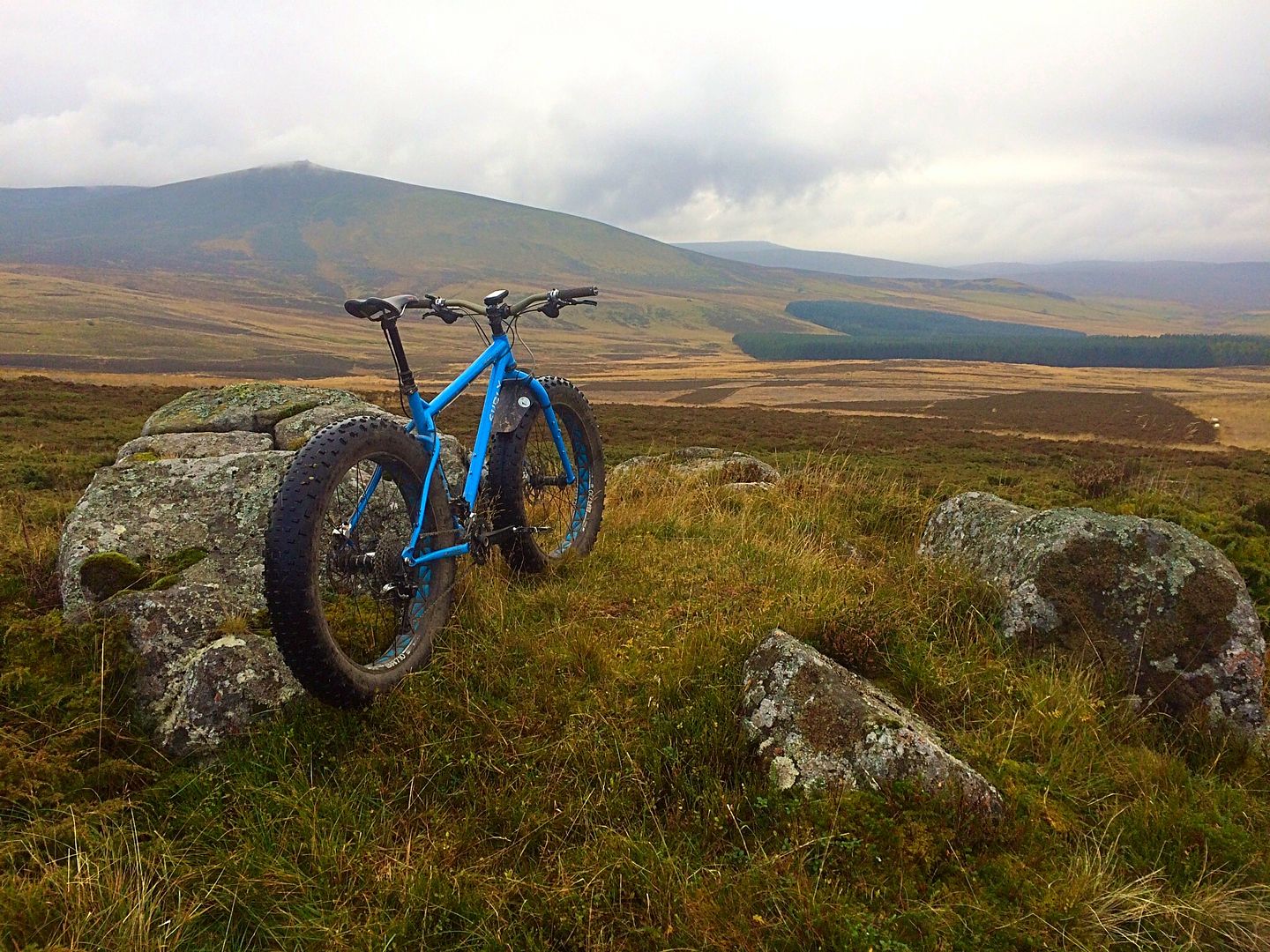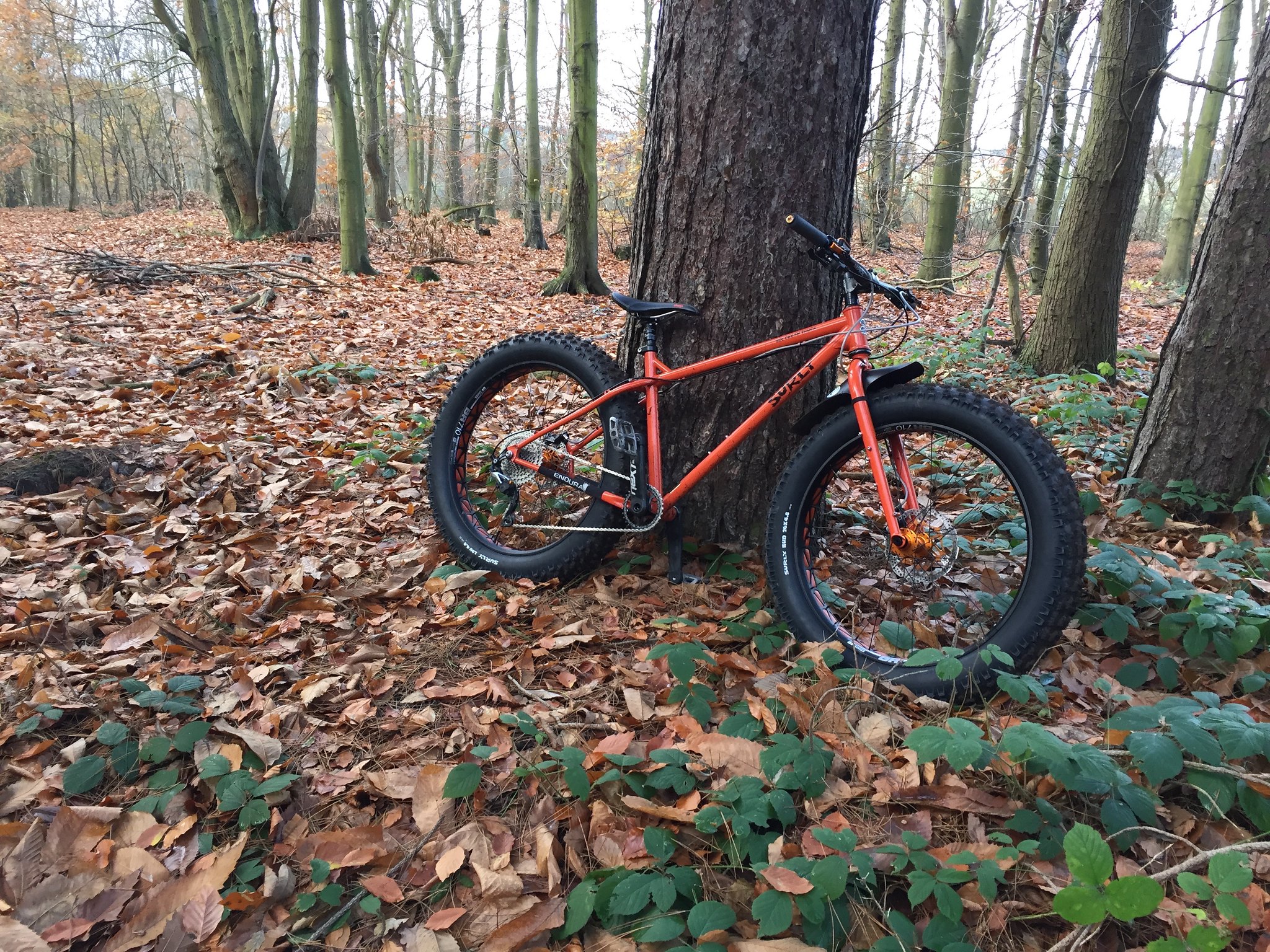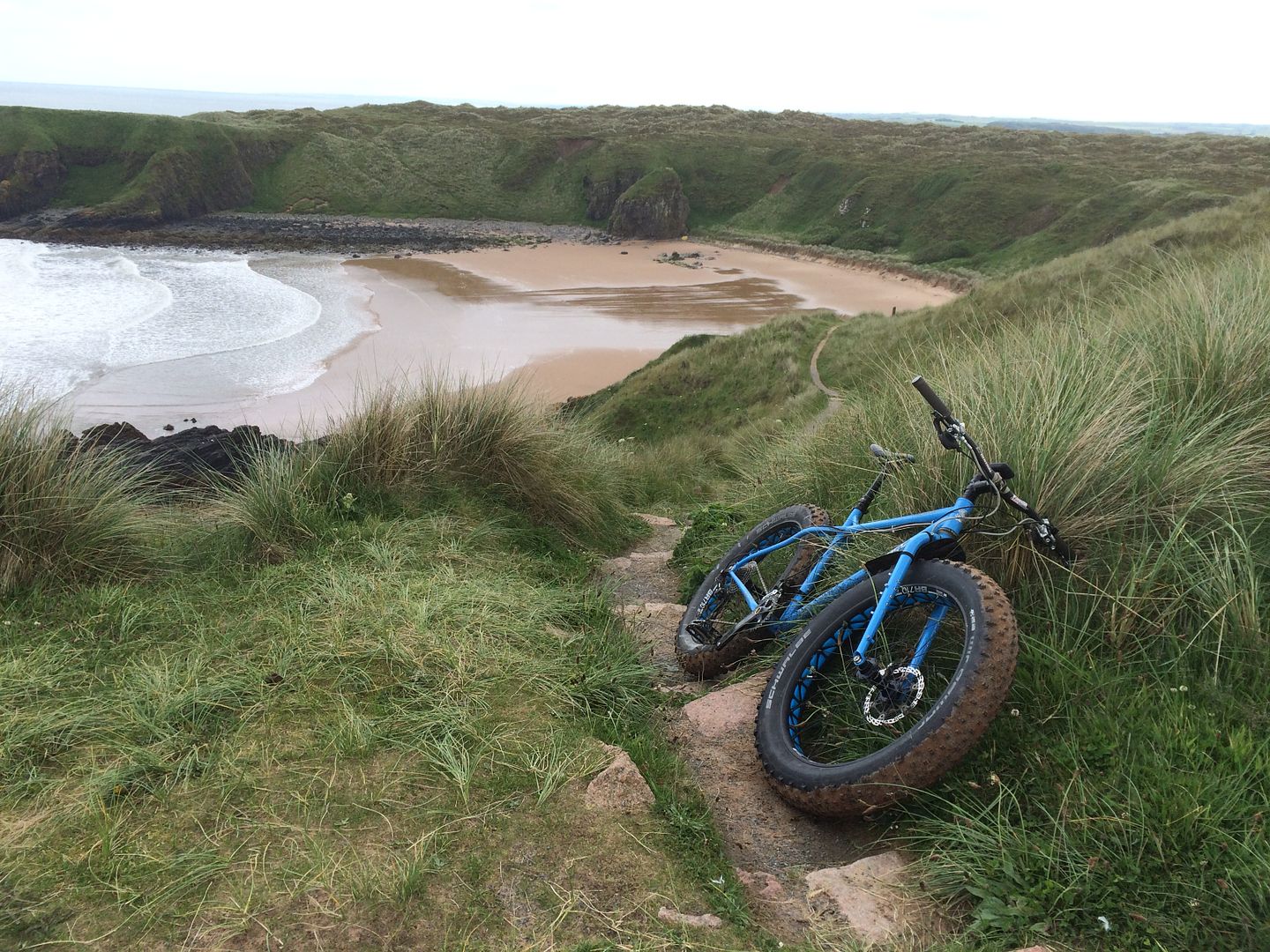- This topic has 43 replies, 21 voices, and was last updated 6 years ago by kaiser.
-
Fat bike – how fat?
-
deejayenFree MemberPosted 7 years ago
From what I’ve picked up, the Pugsley-style bike was the original fat bike with 3.8″ tyres. It looks like the Moonlander-style bike has 4.8″ tyres. Is fatter generally better, or is a 3.8″ bike still worth having? Or perhaps even the Pugsley is too fat for general riding, and a Krampus or 29er might be better.
I’m considering buying a frameset for 3.8″ tyres with 170mm rear spacing and 135mm front forks. How much is a build likely to cost? Are the wheels and tyres going to be really expensive?
fin25Free MemberPosted 7 years agoIf you’re just riding the same trails you would on any other mtb, then 3.8 will suffice. I’d look at 150mm front hub spacing to keep it bluto compatible though, just to keep your options open.
rickmeisterFull MemberPosted 7 years agoThere will be a million, if not more, opinions on this, but after a couple of builds…
Fork, personally, I wouldn’t go with a Bluto
It will be worth 1x anything for gearing, SRAM or Shimano, I bet the chain may rub on the tyre with a 2x drive
Brakes, hydraulic will be fine for a non beach bike, or be ocd on cleaning, if not, go mechanical if beaches figure highly
Wheels, it’s where all the weight is. Consider proper tubeless rims from the outset, Nexties, ICAN or something. A fatbike rim is full of hole and can be ghetto tubeless, but save the trouble from the outset.
Be careful with”standards” as Fatbikes have some strange stuff like disc spacing on hubs… Just check everything
Tyres… We have reached the “20’s on a Corsa” moment with xxl tyres. 3.8 / 4.0 will be just fine
Cranks, again, lot to choose from. Most use standard htII cups with a longer center tube.. Buy ones to match Bb shell
Buy cranks for a 170 rear as the chain line will work well. Race face are pretty good.Good luck, enjoy the build…. And others will be along soon with their opinions too, I’m sure.
fd3chrisFree MemberPosted 7 years agoI’ve had a couple of 4 inchers and loved them . Now I have a trek with 4.8 and love it more even on normal forest ( woburn) trails. It really is a personal thing. No one can say one is better than another. Try both if you can and see what you think.
futonrivercrossingFree MemberPosted 7 years agoUnless you’re riding on snow a lot, then 3.8” for the rear, and 4.8” for the front would be my choice, with 65mm Carbon rims.
roverpigFull MemberPosted 7 years agoI tend to the view that, if you are going fat, you might as well go as fat as you can. If you go too far you can always back it off a bit. But most “new” developments in mountain bikes generate endless comments in magazines and online, then turn out to be a barely noticeable change in practice, so it’s worth trying a big jump.
Personally 4.8s seem to suit me all year round, but others will disagree.
Denis99Free MemberPosted 7 years agoAgree with much of the above , but I will be experimenting with a 4.8 tyre up front and changing back to the Lauf Carbonara fork for the winter.
Hoping to see if the bigger tyre and Lauf give good squish performance compared to the Bluto.
cozzFree MemberPosted 7 years agoI have had several fat bikes (about 8 or so) in the last 7 years
I stepped upto the fatter 4.8’s cos I’m a fatter rider! and they give more float
2 of my current fat bikes have them on
one has 3.8 rear and 4.8 front(in a bluto (jumbo jims)
One has 4.8 Surly BUD’s front (on a lefty) and rearone thing to mention, is that the rims width has quite an effect.
A 4.8 on a 65mm rim comes up much smaller then on a 100mm rim (which of course are awesome – but also over the top for most people/rides, but that doesn’t bother me)I ride them cos they are fun, not because they make sense
rosscopecoFree MemberPosted 7 years agofuton river crossing – Member
Unless you’re riding on snow a lot, then 3.8” for the rear, and 4.8” for the front would be my choice, with 65mm Carbon rims.+1
I’ve been on everything in between with more or less every tyre combo out there. Unless you’re riding on snow….
I’d also echo the 150mm front end. Just in the process of ‘upgrading’ mine from 135 to 150 for this reason. They’ll also fit my new Ti Truss forks when the arrive from the far east!
dovebikerFull MemberPosted 7 years agoBeen riding fat for 2 years now and 29+ a year before that. Frame standards have ‘normalised’ at 150x15mm front and 197x12mm rear – going 170mm rear might limit your choices in the future. Tyre and rim size really depends on the type of conditions you’re riding – 4″ tyres on 65mm are a great choice for UK summer riding and hardpack, but will come-up short against a bigger tyre and rim combo in really soft conditions like deep sand and snow – it can make the difference between riding and walking. A 197mm frame will also take a 29+ wheel. Been running 65mm rims on a 197mm frame, but just built some 90mm rims and fitted Snowshoe 2XLs which are the biggest tyres available for a planned trip to the arctic – the great thing about fatbikes is they are so adaptable. Suggest you test ride a few and make your choice.
dovebikerFull MemberPosted 7 years agoTo add, the likes of Hope are discontinuing 170\177mm hubs so might limit upgrade paths in the future
deejayenFree MemberPosted 7 years agoThanks for all the great info. There’s a lot to know about the different standards, including hub widths, axle sizes, brake rotor position, and BB widths.
Dovebike, does the Surly Ice Cream Truck fall into those ‘normalised’ standards?
scotroutesFull MemberPosted 7 years agoHave a look at built bikes rather than buying a frameset and then trying to match up compatible parts.
roverpigFull MemberPosted 7 years agoI have an ICT, it’s awesome.
Works for me too 🙂
Jumbo Jims in the summer, Bud and Lou in the winter (both 4.8); job done.
I might try the new 4.4″ JJs (with a Bluto) next summer, just for a change. But I had so much fun on the 4.8″ JJs (rigid) this year that I might just stick with that.
deejayenFree MemberPosted 7 years agoYes, I’m thinking that buying a complete bike is probably the way to go. It sounds like it could be tricky getting all the correct parts together if you don’t know what you’re doing, and I imagine buying individual components for the wheels could be expensive.
fin25Free MemberPosted 7 years agoBe aware that the older, blue ICT comes with 100mm rims and 4.8 tyres, while the old ops has 80mm rims and 3.8 tyres. I’m not sure if there’s many of either left and the new yellow one prob. Won’t be showing up any time soon (I think that has 4.8 tyres on 80mm rims). Whichever one you go with, it will be awesome.
cozzFree MemberPosted 7 years agoyes, its weird that a bike designed around 100mm rims and 4.8 tyres now you cannot buy with 100mm rims !
st4nleyFree MemberPosted 7 years agoICT, works here too.
[url=https://flic.kr/p/PHPjkr]IMG_2475[/url] by Tony Hall, on Flickr
JohnClimberFree MemberPosted 7 years agoDenis99 – Member
Agree with much of the above , but I will be experimenting with a 4.8 tyre up front and changing back to the Lauf Carbonara fork for the winter.Hoping to see if the bigger tyre and Lauf give good squish performance compared to the Bluto.
roverpig – Member
Jumbo Jims in the summer, Bud and Lou in the winter (both 4.8); job done.Agreed with both of the above points, 4.8″ especially if you ride on beaches from time to time.
Here’s mine early this morning after a beach bivi out
roverpigFull MemberPosted 7 years agoOh yes, I forgot the obligatory beach shot 🙂
I do find those big tyres are just as much fun on peat bogs and loose rock too though.
you can get your 4.8 JJ in a bluto
Yes, that will probably be the first thing I try next spring, although there is a lot of winter to enjoy first.
Loving the orange ICT by the way @st4nley
NorthwindFull MemberPosted 7 years agofin25 – Member
If you’re just riding the same trails you would on any other mtb, then 3.8 will suffice.
TBH I’d go totally the other way round. For some stuff 3.8 nates and the like are awesome and a lot of it is stuff you wouldn’t want to ride on a normalbike. And size can become a downside for mudplugging. But for trailbike use, riding fast on rough stuff you either need volume or pressure to avoid flats, and higher pressure pretty much defeats the point of a fatbike.
If 4.0 was as big as fatbikes went I doubt I’d have kept mine more than a month or so. 9psi in a 4.0 was utter rubbish and flats and rim dings was worse. 5 or 6 psi in the 4.8 JJs or minions is what I want.
Fatbike choices are all made complicated by the fact people want them to do different things. At the end of the day, for a lot of us if the question is “what’s best” then the answer isn’t 4.8 or 4 or 3.8, its 2.3. But the reason I have a fatbike is because it’s not best.
fin25Free MemberPosted 7 years agoAt the end of the day, for a lot of us if the question is “what’s best” then the answer isn’t 4.8 or 4 or 3.8, its 2.3. But the reason I have a fatbike is because it’s not best.
Spoken like a true fattist.
rOcKeTdOgFull MemberPosted 7 years agoSand & snow bigger is best including rims, dicking about in the woods nothing bigger than 4″ & 80mm rim
SannyFree MemberPosted 7 years agohttp://singletrackworld.com/reviews/long-termer-surly-ice-cream-truck-part-3/
Hope this helps? 😆
Cheers
Sanny
roverpigFull MemberPosted 7 years agoCertainly helped me Sanny 🙂
I think Northwind has nailed it. Low pressures are what makes fat bikes fun (for me at least). Once I get higher than around 8psi most of the fun disappears. It’s rocky up here and I like to (at least try to) go fast. Or maybe I’m just clumsy. Either way, pinch flats are an issue and my worry with 3.8s is that I’d need to go higher than 8psi to save my rims.
rOcKeTdOgFull MemberPosted 7 years agoEither way, pinch flats are an issue and my worry with 3.8s is that I’d need to go higher than 8psi to save my rims.
Tubeless FTW
roverpigFull MemberPosted 7 years agoOh yes, I’ve been tubeless since day one on the fat bike. Can’t see any reason not to be. But I’m still capable of pinch flaring a tyre or killing a rim. Usually with my clumsy attempts to get over water bars without slowing down. Better technique is the real answer, but until that happens I’ll keep the extra margin for error.
Fat is fun, fatter is funnerer, so why would I opt for less fun? That’s my logic anyway.
To be clear though: I’ve not spent more than a short demo ride on 3.8s. Maybe they’d be fine, but I jumped straight to 4.8, loved it and am reluctant to go for anything less now.
I don’t really get the “you don’t need more than X unless you are doing Y” argument though. I’m riding round in circles to get muddy, what has need got to do with anything 😀
deejayenFree MemberPosted 7 years agoThat’s great! The photos are brilliant, and Sanny’s articles make the ICT sound really appealing.
The only thing is, in the last paragraph Sanny mentions carrying the bike on ‘hike-a-bike’ sections, after giving the impression the bike can be pedaled over anything!
NormalManFull MemberPosted 7 years agoDon’t know about Sanny but for me it’s often legs or lungs that give up before the bike does!!
NorthwindFull MemberPosted 7 years agorOcKeTdOg – Member
Tubeless FTW
It’s a big help but it doesn’t protect your rims. (and if you’re using tubeless to get pressures lower, then you’re going to be banging rims) And fatbike rims tend to be expensiv-. I don’t mind dinging my £25 Frequencies on the thin bike that much but with my BR710s, **** that.
TBH I reckon that the main reason you get such different opinions on this stuff, is that more than most bikes these days, people use their fatbikes for such different things. Like, mine can be seen as a rigid XC bike and that’s broadly what they were, traditionally- just with some extra tricks and capabilities.
But I love riding it on the tweed valley’s #enduro and dh trails, which even now most folks don’t consider fatbike territory- but it is and it’s fantastic. So it’s no wonder what the fat xcist or beachrider or iditarod racer thinks is ideal, isn’t the same as what I think’s ideal. Neither side is wrong of course but I think both are quite bad at understanding the other perspective.
Maybe a useful thing to do is just think “what sort of bike would I buy to do this, if it wasn’t a fatbike”. For some people, there’s no alternative. For some it’d be an Adventure Bike, for some it’d be an allrounder XC bike, for me it’d be something like an Orange Alpine 😆 That helps understand that we all want something different even from the exact same bike but also reminds why the bikes we have are so versatile.
I remember getting what sounded like sound advice, “it’s very hard to flat on a fatbike, so go with skinny tubes and low pressures, it’ll be find”. And then got 2 or 3 punctures in every ride. It wasn’s bad advice, it was just situational- the very experienced fatbike rider who said it, just assumed my fatbiking was the same as his, ie simple trails and beaches.
Essay is over 🙂
fattyre500Free MemberPosted 7 years agohttps://flic.kr/p/PbdmcW
The whole fat bike thing is about having FUN!! Forget your Strava trophy that you got from ebay for being the quickest person up the road outside your house and the whole ‘i must goes as fast as possible’ mantra and go out there and ride the blummin’ thing just for the hell of it!
Bimble across landscapes previously unrideable on other bikes,soak up the great outdoors and then when you get home go onto the uk fat bike forum and enjoy probably the most chilled out and helpful forum on the net!
Haven’t touched any of my other bikes since i got into the fat scene at the start of this year.letmetalktomarkFull MemberPosted 7 years agoMy 2 Cents …..
I have a Singular Puffin that I’ve owned for 3(?) years now.
I started off with a Nate front and back on 65mm rims. I’m unlikely to go off riding beaches etc so went for the narrower rim.
When the first winter came I swapped my Nate out front for a Bud as whilst much larger it rolls much better than the Nate.
Tinkering …. I can squeeze a 4.8 in the rear of my Puffin again on a 65mm rim.
I’d say for General riding 4″ tyres on 65mm rims works, well it does for me. I’m 95ish kg and even with single digit pressures my rims have been fine.
Now a bit of a curve ball …… what about 650b+?
I was out earlier on mine 3″” tyres front and rear on Hugo rims 100/135mm spacing. The tyres are true 3″ tyres.
I would say it’s quicker than my Puffin but almost as grippy and comfortable with the benefit of retaining a lot of “std” standards.
If I were to do the whole thing over again would I go fat …… probably but, again for me, 650b+ is more versitile.
NorthwindFull MemberPosted 7 years agoI dabbled with b+ but just figured it’s flat out not as good as a 29er for my riding, and not as entertainingly different as a fatbike. I kind of expected to like it tbh but I don’t think there was a single moment when I wouldn’t rather have had my 29er wheels in. I can see more appeal in a hardtail mind.
scotroutesFull MemberPosted 7 years agoIf you have B+ and are considering full fat too then I’d certainly recommend going 4.8 – 5″.
deejayenFree MemberPosted 7 years agoIs an original Pugsley worth a punt, or are the double-walled Large Marge rims and Endomorph tyres a bit too heavy and old hat?
The topic ‘Fat bike – how fat?’ is closed to new replies.




